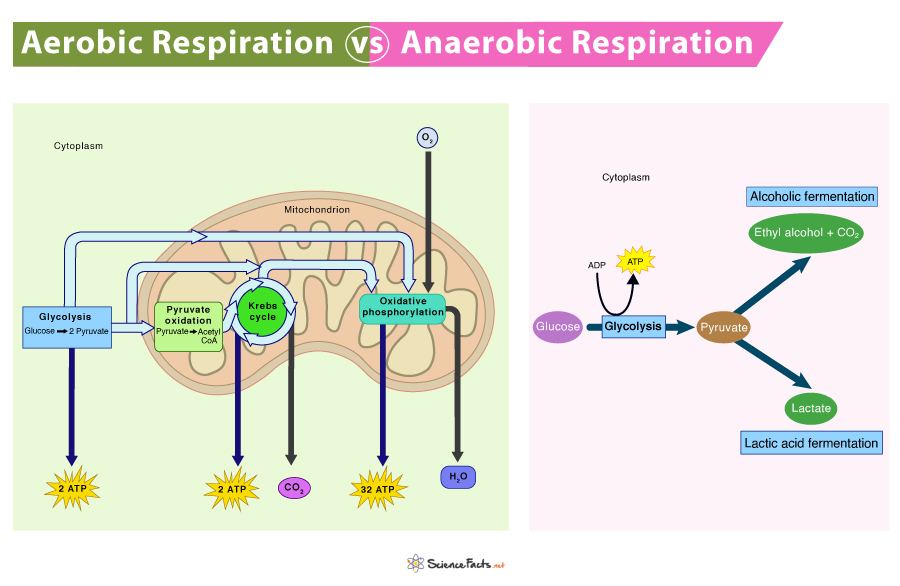Aerobic vs Anaerobic Respiration
Cellular respiration is the process by which cells release energy by breaking down glucose molecules. It is broadly categorized into two types: aerobic and anaerobic.
What are Aerobic and Anaerobic Respiration
Aerobic respiration is the process through which cells break down the glucose molecule to convert its stored biochemical energy into energy-coin Adenosine triphosphate (ATP) in the presence of oxygen. This type of respiration is the primary energy-yielding process of all living beings, providing all the energy to maintain life.
Anaerobic respiration, the most primitive form of respiration on earth, is how cells convert the stored energy of glucose into ATP in the absence of free oxygen. It provides energy to the cells very rapidly.
Compare and Contrast
As stated, both types of respiration aim to produce energy from glucose. However, two processes do not follow the same pathway and are not equivalently efficient. Although some cells may undergo just one type of respiration, most cells use both types, depending on an organism’s needs.
What is the Difference between Aerobic and Anaerobic Respiration
| Basis | Aerobic Respiration | Anaerobic Respiration |
|---|---|---|
| 1. Site of Reaction | i) In eukaryotes: cytoplasm and mitochondria ii) In prokaryotes: cytoplasm | i) In eukaryotes: cytoplasm ii) In prokaryotes: cytoplasm |
| 2. Final electron acceptor | Oxygen | Sulfate(SO4–) or nitrate ion (NO3–) |
| 3. Amount of Energy Released | More (38 ATPs) | Less ( 2 ATPs) |
| 4. Nature of the Process | Slow | Fast |
| 5. Exchange of Gases | Occurs | Does not occur |
| 6. Stages | Glycolysis, Krebs cycle or citric acid cycle, and electron transport chain (ETC) | Glycolysis, fermentation, and electron transport chain (ETC) |
| 7. Equation | C6H12O6 (Glucose) + 6O2 → 6CO2 + 6H2O + Energy (38 ATPs) | C6H12O6 (Glucose) → 2C3H6O3 (Lactic acid) + Energy (2 ATPs) |
| 8. Presence of Oxygen | Present | Either low or absent |
| 9. Reactants | Glucose and oxygen | Glucose |
| 10. End Products | Carbon dioxide, water, and ATP | Ethanol and CO2 or lactate |
| 11. Production of Ethanol or Lactic Acid | Not produced | Produced |
| 12. Oxidation of Carbohydrate | Complete | Incomplete |
| 13. Occurs in | Most of the higher organisms like plants and animals | Mostly in primitive prokaryotes, also in the muscle cells in humans during extreme movements |
| 14. Examples | i) Respiration in humans ii) Respiration in plants | i) Lactic acid production in muscles ii) Alcohol fermentation in yeast |
| 15. Advantages | i) Complete breakdown of glucose ii) Maximum yield of energy | i) Produces energy faster ii) Allows organisms to live in places with very little or no oxygen |
| 16. Disadvantages | i) Slow process | i) Partial breakdown of glucose ii) Very less energy is produced |
Similarities
- Both oxidize similar substrate, glucose
- Both produce ATP
FAQs
Ans. Both anaerobic and aerobic respirations require glucose.
Ans. Cellular respiration comprises both aerobic and anaerobic respiration.
Ans. In fermentation, an organic molecule, pyruvate, is used to regenerate NAD+ from NADH. On the other hand, in aerobic and anaerobic respiration, glucose gets broken down in the presence and absence of oxygen, respectively, yielding ATP.
-
References
Article was last reviewed on Thursday, February 2, 2023




